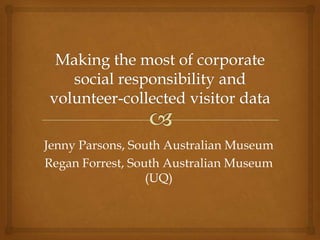
Making the most of Corporate Social Responsibility and Volunteer-collected visitor data
- 1. Jenny Parsons, South Australian Museum Regan Forrest, South Australian Museum (UQ)
- 2. Presentation Overview Project context Volunteer data collection What to do with the data? Data analysis Applying the findings Lessons learned
- 3. Project context The Opportunity Official Reason Unofficial Reason Desired Outcomes A better visitor experience Relationship development Institutional learning
- 4. Australian Aboriginal Cultures Gallery (AACG) 10yr old gallery What needed to be updated? What was missing? Or worse, what was broken….. Opening up our internal discussions in order to consider the visitor experience
- 5. Volunteer-led data collection The idea: The Museum is Watching You, WSJ August 18, 2010 Consultation with Matt Sikora, Detroit Institute of Arts' director of evaluation Creating the map, evaluator letters, signage & learning about “stops” Dream Team: financial analysts No budget, entrepreneurial approach
- 7. Descriptive Statistics Sample size n=92, 59 males and 64 females (G Floor) Mean Dwell Time: 9.1 minutes 13-18 Median Dwell Time: 5.0 minutes 19-39 40-65 Mode Dwell Time: 5.0 minutes 65+ Approx. SRI* = 600 sq.ft. / min (*SRI= Sweep Rate Index as defined in Serrell, B. (1998) Paying Attention: Visitors and Museum Exhibitions. Published by the American Association of Museums)
- 8. AACG Dwell Time 35 30 25 Number of visitors 20 15 10 5 0 1-3 4-6 7-9 10-12 13-15 16-18 19-21 22-24 25-27 28-30 30+ Minutes spent in gallery
- 9. Visitor Entry Paths: 64% 20% 18%
- 10. Median Dwell Visitors (n=11)
- 11. Gallery zoning – example from the literature Klein, HJ (1993) Tracking Visitor Circulation in Museum Settings. Environment and Behavior 1993 25: 782-800. p. 792
- 12. Zoning the AACG 1 entry Direction = 90 2 entries Direction = n/a 1 entry Direction = • Overlay gallery plan to divide 135 into 24 „zones‟ • Count each entry into a zone as 1 entry well as overall direction where Direction = n/a applicable • Code direction numerically (0, 45, 90, 135, 180, 235, 270, 315) 2 entries Direction = 90
- 13. Number Crunching Rest assured – this looks a lot nastier than it really is! Sum of entries for each zone Compare Comparison Mode reveals with to „average‟ (Total entries most opposite for all zones common direction /24) direction
- 14. Visually Representing Visitor Movement
- 15. What this told us and how we used it Important sections were in „visitation deserts‟ brought the light levels up Clear biases in visitor routes moved the new introductory wall The first floor was a racetrack new colourful display with seating & touchscreens
- 16. The AACG Renovation Before After
- 17. Lessons learned Visitor tracking relies on expert knowledge It‟s essential in understanding and improving the experience of our visitors It has given us a better gallery It needs to reside somewhere in the Museum Beta exercise. Activating Corporate Social Responsibility takes strong collaboration internally but can build relationships & lead to giving.
- 18. Questions?
